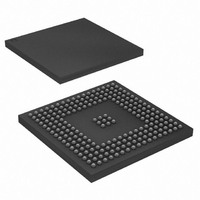AT91SAM9RL64-CU Atmel, AT91SAM9RL64-CU Datasheet - Page 311

AT91SAM9RL64-CU
Manufacturer Part Number
AT91SAM9RL64-CU
Description
IC ARM9 MCU 217-LFBGA
Manufacturer
Atmel
Series
AT91SAMr
Specifications of AT91SAM9RL64-CU
Core Processor
ARM9
Core Size
16/32-Bit
Speed
240MHz
Connectivity
EBI/EMI, I²C, MMC, SPI, SSC, UART/USART, USB
Peripherals
AC'97, LCD, POR, PWM, WDT
Number Of I /o
118
Program Memory Size
32KB (32K x 8)
Program Memory Type
ROM
Ram Size
72K x 8
Voltage - Supply (vcc/vdd)
1.08 V ~ 1.32 V
Data Converters
A/D 6x10b
Oscillator Type
Internal
Operating Temperature
-40°C ~ 85°C
Package / Case
217-LFBGA
Processor Series
AT91SAMx
Core
ARM926EJ-S
Data Bus Width
32 bit
Data Ram Size
64 KB
Interface Type
2-Wire, SPI, SSC, USART
Maximum Clock Frequency
240 MHz
Number Of Programmable I/os
118
Number Of Timers
4
Maximum Operating Temperature
+ 85 C
Mounting Style
SMD/SMT
3rd Party Development Tools
JTRACE-ARM-2M, MDK-ARM, RL-ARM, ULINK2
Development Tools By Supplier
AT91SAM-ICE, AT91-ISP
Minimum Operating Temperature
- 40 C
On-chip Adc
10 bit, 6 Channel
Controller Family/series
AT91SAM9xxx
No. Of I/o's
118
Ram Memory Size
64KB
Cpu Speed
240MHz
No. Of Timers
1
Rohs Compliant
Yes
Package
217LFBGA
Device Core
ARM926EJ-S
Family Name
91S
Maximum Speed
240 MHz
Operating Supply Voltage
1.8|3.3 V
For Use With
AT91SAM9RL-EK - KIT EVAL FOR AT91SAM9RLAT91SAM-ICE - EMULATOR FOR AT91 ARM7/ARM9
Lead Free Status / RoHS Status
Lead free / RoHS Compliant
Eeprom Size
-
Lead Free Status / Rohs Status
Lead free / RoHS Compliant
Available stocks
Company
Part Number
Manufacturer
Quantity
Price
Company:
Part Number:
AT91SAM9RL64-CU
Manufacturer:
ATMEL
Quantity:
16
Company:
Part Number:
AT91SAM9RL64-CU
Manufacturer:
ATMEL
Quantity:
255
Part Number:
AT91SAM9RL64-CU
Manufacturer:
ATMEGL
Quantity:
20 000
- Current page: 311 of 903
- Download datasheet (13Mb)
29.7.6
29.7.7
6289C–ATARM–28-May-09
Spurious Interrupt
General Interrupt Mask
Interrupt Status Register (AIC_ISR), is updated with the current interrupt only when AIC_IVR is
written.
An AIC_IVR read on its own (e.g., by a debugger), modifies neither the AIC context nor the
AIC_ISR. Extra AIC_IVR reads perform the same operations. However, it is recommended to
not stop the processor between the read and the write of AIC_IVR of the interrupt service routine
to make sure the debugger does not modify the AIC context.
To summarize, in normal operating mode, the read of AIC_IVR performs the following opera-
tions within the AIC:
However, while the Protect Mode is activated, only operations 1 to 3 are performed when
AIC_IVR is read. Operations 4 and 5 are only performed by the AIC when AIC_IVR is written.
Software that has been written and debugged using the Protect Mode runs correctly in Normal
Mode without modification. However, in Normal Mode the AIC_IVR write has no effect and can
be removed to optimize the code.
The Advanced Interrupt Controller features protection against spurious interrupts. A spurious
interrupt is defined as being the assertion of an interrupt source long enough for the AIC to
assert the nIRQ, but no longer present when AIC_IVR is read. This is most prone to occur when:
The AIC detects a spurious interrupt at the time the AIC_IVR is read while no enabled interrupt
source is pending. When this happens, the AIC returns the value stored by the programmer in
AIC_SPU (Spurious Vector Register). The programmer must store the address of a spurious
interrupt handler in AIC_SPU as part of the application, to enable an as fast as possible return to
the normal execution flow. This handler writes in AIC_EOICR and performs a return from
interrupt.
The AIC features a General Interrupt Mask bit to prevent interrupts from reaching the processor.
Both the nIRQ and the nFIQ lines are driven to their inactive state if the bit GMSK in AIC_DCR
(Debug Control Register) is set. However, this mask does not prevent waking up the processor if
it has entered Idle Mode. This function facilitates synchronizing the processor on a next event
and, as soon as the event occurs, performs subsequent operations without having to handle an
interrupt. It is strongly recommended to use this mask with caution.
1. Calculates active interrupt (higher than current or spurious).
2. Determines and returns the vector of the active interrupt.
3. Memorizes the interrupt.
4. Pushes the current priority level onto the internal stack.
5. Acknowledges the interrupt.
• An external interrupt source is programmed in level-sensitive mode and an active level occurs
• An internal interrupt source is programmed in level sensitive and the output signal of the
• An interrupt occurs just a few cycles before the software begins to mask it, thus resulting in a
for only a short time.
corresponding embedded peripheral is activated for a short time. (As in the case for the
Watchdog.)
pulse on the interrupt source.
AT91SAM9R64/RL64 Preliminary
311
Related parts for AT91SAM9RL64-CU
Image
Part Number
Description
Manufacturer
Datasheet
Request
R

Part Number:
Description:
MCU, MPU & DSP Development Tools KICKSTART KIT FOR AT91SAM9 PLUS
Manufacturer:
IAR Systems

Part Number:
Description:
DEV KIT FOR AVR/AVR32
Manufacturer:
Atmel
Datasheet:

Part Number:
Description:
INTERVAL AND WIPE/WASH WIPER CONTROL IC WITH DELAY
Manufacturer:
ATMEL Corporation
Datasheet:

Part Number:
Description:
Low-Voltage Voice-Switched IC for Hands-Free Operation
Manufacturer:
ATMEL Corporation
Datasheet:

Part Number:
Description:
MONOLITHIC INTEGRATED FEATUREPHONE CIRCUIT
Manufacturer:
ATMEL Corporation
Datasheet:

Part Number:
Description:
AM-FM Receiver IC U4255BM-M
Manufacturer:
ATMEL Corporation
Datasheet:

Part Number:
Description:
Monolithic Integrated Feature Phone Circuit
Manufacturer:
ATMEL Corporation
Datasheet:

Part Number:
Description:
Multistandard Video-IF and Quasi Parallel Sound Processing
Manufacturer:
ATMEL Corporation
Datasheet:

Part Number:
Description:
High-performance EE PLD
Manufacturer:
ATMEL Corporation
Datasheet:

Part Number:
Description:
8-bit Flash Microcontroller
Manufacturer:
ATMEL Corporation
Datasheet:

Part Number:
Description:
2-Wire Serial EEPROM
Manufacturer:
ATMEL Corporation
Datasheet:











